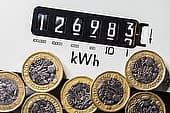Home > Energy > News > Community projects to cut energy bills by £300 get funding
Community projects to cut energy bills by £300 get funding
COMMUNITY 'go green' projects to reduce carbon emissions and cut home energy bills got a £10 million boost from the Government this week.

"I want to encourage groups of people across the country to participate in a community energy movement and take real control of their energy bills," Energy and Climate Change Secretary Ed Davey said.
Community groups could use a grant from the £10 million Urban Community Energy Fund to install their own wind turbines, as a small Scottish village, Fetterangus, did at the end of last year.
Or the money could be used to kick start a community owned hydroelectric power plant, like the Torrs Hydro project in New Mills, near Manchester.
Some green community projects have reduced energy bills as well as carbon emissions: the ministers cited a Cheshire project as saving households £300.
Ministers said that community projects had the potential to make a big impact on UK energy and, in the future, could even put pressure on energy suppliers to drive down prices.
"We want to help more consumers of energy to become producers of energy and in doing so help to break the grip of the dominant big energy companies," the Liberal Democrat in the energy department, Greg Barker, said.
Cutting bills?
Perhaps one day community energy projects will grow large enough to affect the big energy suppliers and bring down prices for everyone, though given just how big those suppliers are it's probably fair to say that we're looking quite far into the future there.
People considering rallying their parish council, faith group or other community group to action on energy have a more pressing concern with bills, though.
Does community action on green issues really cut costs?
To find out let's take a closer look at the example the Government used this week - the £300 example - comes from the Ashton Hayes Going Carbon Neutral project in Cheshire.
Ashton Hayes, a village of about 1,000 people, decided to go carbon neutral in 2006 and has, for most of that time, focused on behavioural change to cut energy use.
The village estimates that it's cut carbon dioxide emissions by 23% and many households have translated those significant cuts in use into cuts in bills.
Just look at these graphs [pdf] of one resident's use to see how dramatic the reduction has been in some cases.
Although £300 on average sounds about right those cuts haven't been evenly distributed, one of the project's founders told me.
Some households have installed PV and ground source heat pumps which could have reduced costs but come with a high installation cost, for example.
The local pub saves £200 a month as a result of their improvements but others have saved much less and, as we reported last week, energy saving estimates are tricky things.
Ashton Hayes doesn't yet have a source of renewable energy, though they're working on it, but the high cost of such improvements gives them the potential to eat into savings, too.
Though, tantalisingly, feed-in tariffs mean that energy sources like turbines or biomass could potentially pay for themselves and then some, the reality is that communities will have to repay hefty loans as part of this funding.
How funding works
Like the Rural Community Energy Fund, which has already started handing out money, the Urban Community Energy Fund offers help to communities in two stages.
First, there is a grant of up to £20,000 available for feasibility work, basically getting experts to look at whether the plan for the community is suitable for the setting and will generate enough energy to achieve the aims of the project.
If the study is successful, communities can then apply for a further loan of up to £130,000 to support planning applications and continue to develop the plan.
These projects are not cheap: the wind turbine in Scotland mentioned above cost almost £1.5 million and was funded by, among other sources, a grant from the Big Lottery fund and by a loan from Triodos Bank, an ethical bank that focuses on loans for green projects.
Despite Government support, projects also face numerous barriers.
"At the moment, life is very tough for the innovators making this happen," Chris Church of the UK Low Carbon Communities Network commented this week.
"We need to move beyond warm platitudes and meetings to removing the barriers to progress and we need this to happen fast," he added.
Despite this week's hyperbole, then, while there are obvious benefits to taking part in community green projects and great potential for cutting bills, those benefits are likely to take a lot of time and hard work.
£1 million to help vulnerable households
Faster help might come from another of this week's announcements: another £1 million for the Big Energy Saving Network, a project to help the most vulnerable households save energy.
The money will help charities and other community groups help people to cut bills by switching, taking up energy efficiency offers, like the ECO scheme (more here) or seeking help from suppliers when they are in energy debt, which as we reported here is a service many facing debt because of energy are unaware of.

We are independent of all of the products and services we compare.

We order our comparison tables by price or feature and never by referral revenue.

We donate at least 5% of our profits to charity, and we aim to be climate positive.
Latest News

2 January 2024
Energy prices increase by 5%
23 November 2023
Energy price cap to rise 5% in January 2024
24 October 2023
Energy companies must do more to support customers

